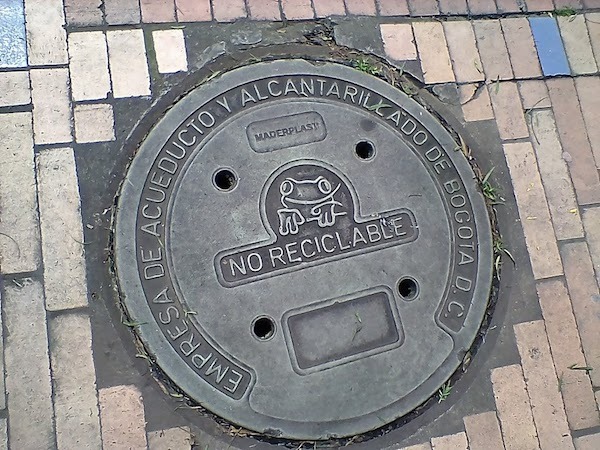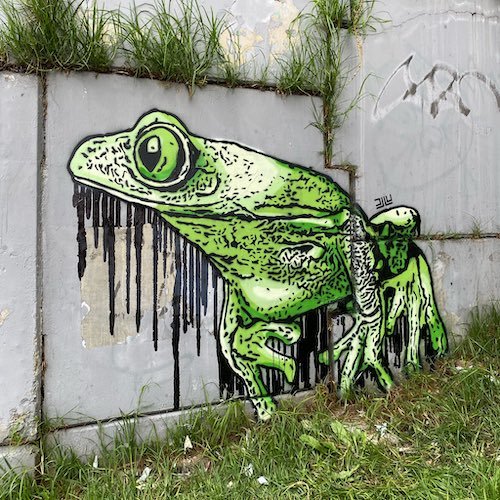La Rana Sabanera: Dendropsophus molitor
Nov. 23rd, 2021 03:57 pmWhen we visited Bogotá in 2018, Wakanomori noticed that the manhole covers had frogs on them:

I always meant to find out the story behind the frog--was it a particular frog? Why a frog? But I never did.
Then the other day, Juegasiempre (also known as DjLu), one of the graffiti artists/muralistas whose work we became acquainted with on that trip, posted this beautiful frog on Twitter: la rana sabenera, Dendropsophus molitor. (Wikipedia tells me in English it's called the green dotted tree frog.) He posted that it used to be very common in the ravines of Bogotá, but now you can hardly find it. (Original tweet here.)

I took it into my head that this MUST be the frog on the manhole covers and finally set about to find the answer.
... Well, it's not. The manhole frog is just a generalized frog, not any particular frog, but I found out that frogs have been on Bogotá's manhole covers for more than a hundred years, getting redesigns now and then. Some people thought the design was of a toad (sapo), so the workers for the Empresa de Acueducto y Alcantarillado (Bogota's water and sewer company) would sometimes be called sapos. This is unfortunate because several years of watching telenovelas has taught me that that's also what you call a snitch.
There's a Facegroup page for people who want to preserve them--it's got some photos:


As for D. molitor, it's found only in Colombia. Females are larger than males, and they can grow to be about 70 mm. They can be green or brown, and some have stripes or lines that can be black, yellow, or blue. Although Wikipedia lists it as a species of least concern, one article I found said it's threatened in parts of Colombia by the introduction of another type of frog that competes for the same habitat.
Here's a cutie from Wikipedia (link):

Live long and prosper, little guy!
Resources consulted
"Conoce a la colorida rana que habita los humedales de Bogotá," Obervatorio Ambiental de Bogotá, 14 September 2020.
"Una rana nueva llega al acueducto," El Tiempo, 5 October 1991.
"Preservemos las Tapas del Acueducto de Bogotá; Disprivatizar el Acueducto" (Facebook page)
"Dendropsophus molitor," Wikipedia.

I always meant to find out the story behind the frog--was it a particular frog? Why a frog? But I never did.
Then the other day, Juegasiempre (also known as DjLu), one of the graffiti artists/muralistas whose work we became acquainted with on that trip, posted this beautiful frog on Twitter: la rana sabenera, Dendropsophus molitor. (Wikipedia tells me in English it's called the green dotted tree frog.) He posted that it used to be very common in the ravines of Bogotá, but now you can hardly find it. (Original tweet here.)

I took it into my head that this MUST be the frog on the manhole covers and finally set about to find the answer.
... Well, it's not. The manhole frog is just a generalized frog, not any particular frog, but I found out that frogs have been on Bogotá's manhole covers for more than a hundred years, getting redesigns now and then. Some people thought the design was of a toad (sapo), so the workers for the Empresa de Acueducto y Alcantarillado (Bogota's water and sewer company) would sometimes be called sapos. This is unfortunate because several years of watching telenovelas has taught me that that's also what you call a snitch.
There's a Facegroup page for people who want to preserve them--it's got some photos:


As for D. molitor, it's found only in Colombia. Females are larger than males, and they can grow to be about 70 mm. They can be green or brown, and some have stripes or lines that can be black, yellow, or blue. Although Wikipedia lists it as a species of least concern, one article I found said it's threatened in parts of Colombia by the introduction of another type of frog that competes for the same habitat.
Here's a cutie from Wikipedia (link):

Live long and prosper, little guy!
Resources consulted
"Conoce a la colorida rana que habita los humedales de Bogotá," Obervatorio Ambiental de Bogotá, 14 September 2020.
"Una rana nueva llega al acueducto," El Tiempo, 5 October 1991.
"Preservemos las Tapas del Acueducto de Bogotá; Disprivatizar el Acueducto" (Facebook page)
"Dendropsophus molitor," Wikipedia.













